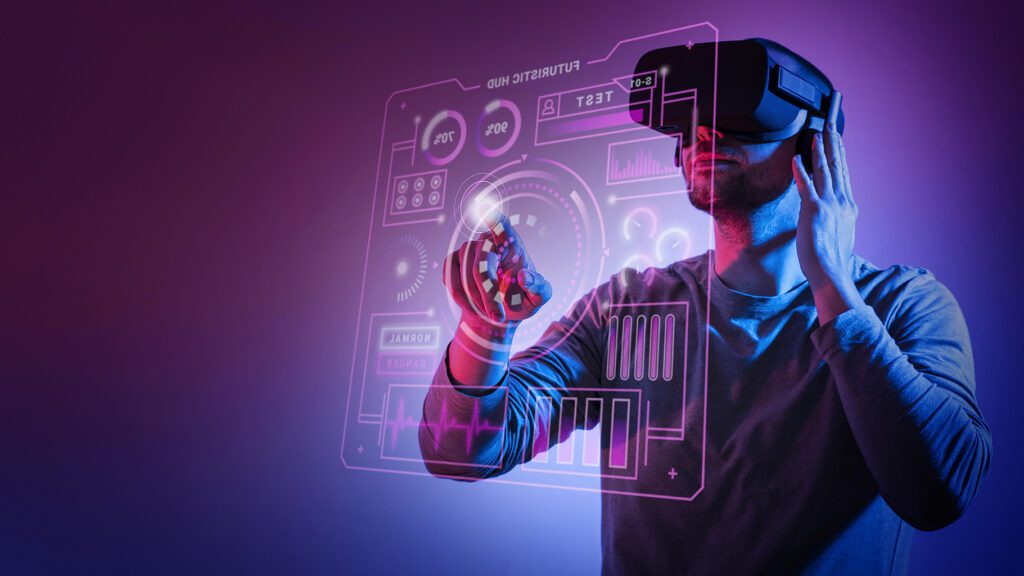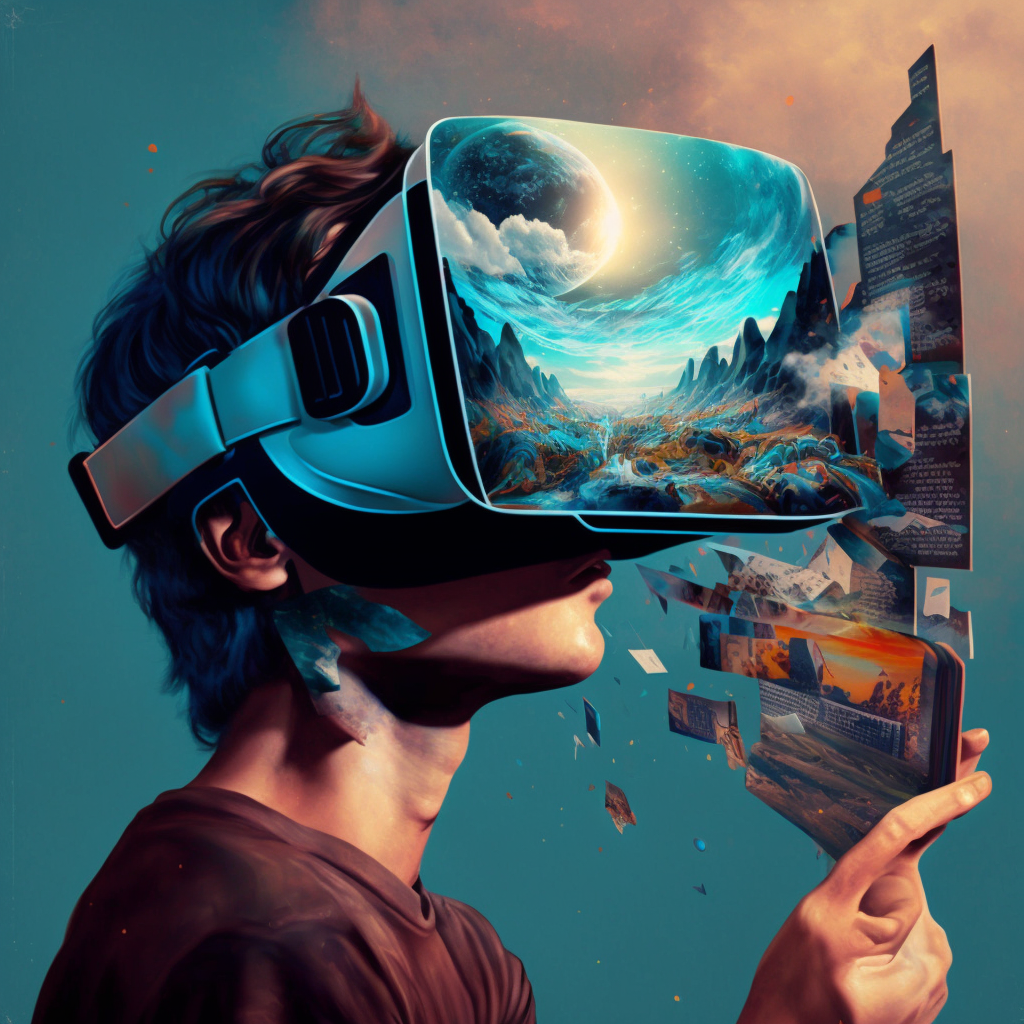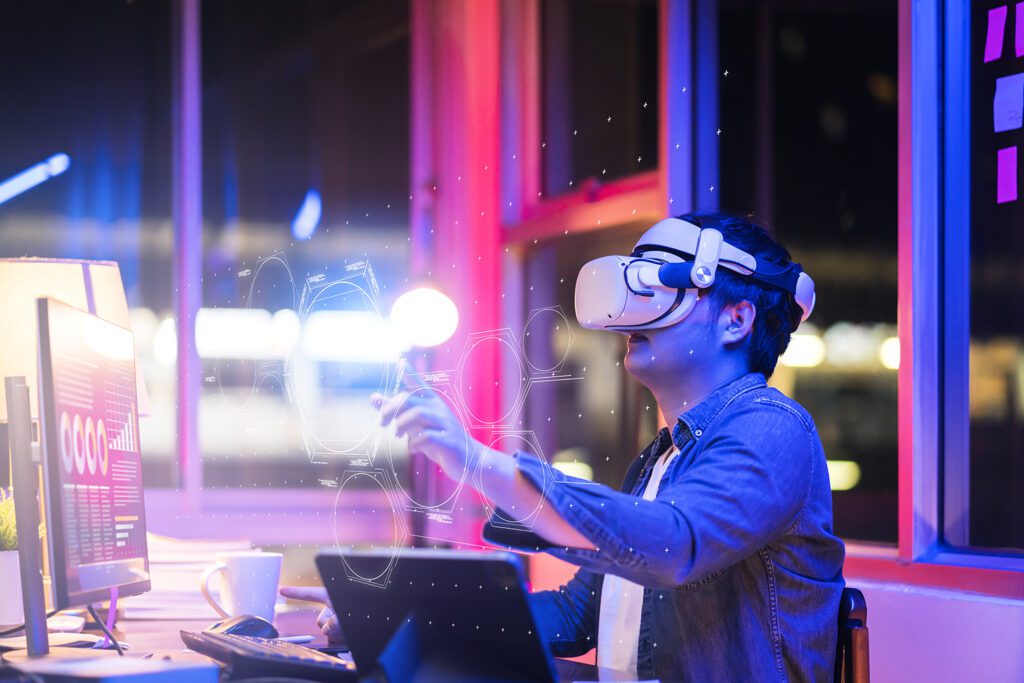The role of AR and VR in the metaverse cannot be understated, as these immersive technologies are not just shaping our digital experiences but are fundamentally redefining how we interact, communicate, and engage with both the real and virtual worlds.
In the ever-evolving landscape of technology, the emergence of the metaverse has taken center stage, captivating the imagination of individuals, businesses, and industries alike. Central to the development and realization of this virtual realm are Augmented Reality (AR) and Virtual Reality (VR) technologies.
In this article, we delve into the intricate web of the metaverse, exploring the multifaceted roles that AR and VR play in its inception, growth, and transformation.

The role of AR and VR in the Metaverse: what does it mean?
“AR” stands for Augmented Reality, whereas “VR” stands for Virtual Reality. Augmented Reality involves overlaying digital information, such as images, videos, or interactive elements, onto the real-world environment. This technology enhances the user’s perception of reality by blending the physical and digital worlds. AR is often experienced through devices like smartphones, tablets, and smart glasses.
On the other hand, Virtual Reality creates an entirely immersive digital environment that users can interact with through specialized headsets and controllers. VR technology transports users to a computer-generated world, isolating them from the physical surroundings and offering a heightened sense of presence and engagement.
Both AR and VR have found applications in various fields, including gaming, entertainment, education, training, healthcare, and industrial design, transforming the way people interact with digital content and their surroundings.
Defining the metaverse: a new digital frontier
Before delving into the immersive technologies of AR and VR, it is crucial to understand the metaverse itself. The metaverse can be envisioned as a collective virtual shared space, merging physical and digital realms into a seamless interconnected environment.
This interconnected space hosts a myriad of digital experiences, ranging from social interactions and entertainment to commerce and education. The role of AR and VR in the metaverse is pivotal to shaping the very essence of this digital realm.
The role of AR and VR in the metaverse is primarily about enhancing our interactions with the digital world.
AR overlays digital content onto the physical world, seamlessly integrating information, objects, and experiences into our immediate surroundings.
VR, on the other hand, transports us to entirely virtual realms, immersing us in experiences that can be indistinguishable from reality. In the metaverse, these technologies converge to create a dynamic landscape of interactions that transcend geographical limitations.

Social connectivity and immersive entertainment
At the heart of the metaverse lies the concept of social interaction. AR and VR technologies provide us with the tools to communicate and connect in ways previously unimaginable.
Imagine attending a virtual gathering with friends from around the world, with VR placing you in the same digital space, while AR enriches the experience with shared content and information.
The role of AR and VR in the metaverse amplifies our capacity to forge connections across distances – bridging cultural gaps and fostering a sense of togetherness.
Entertainment is another realm significantly impacted by the role of AR and VR in the metaverse. Traditional media consumption is evolving as these technologies enable immersive experiences.
Imagine watching a concert where AR enhances the live performance by overlaying interactive visuals or entering a VR simulation of your favorite movie universe.
The metaverse becomes a playground for creators and consumers alike, blurring the lines between reality and fiction.
Commerce and business landscapes
The metaverse isn’t limited to personal interactions; it also carries profound implications for businesses and commerce. The role of AR and VR in the metaverse is redefining how businesses operate and engage with customers.
1. Virtual shopping and retail
E-commerce takes on an entirely new dimension in the metaverse. With VR, customers can step into virtual stores, browse products, and even try them before making a purchase.
AR brings products into our physical surroundings, allowing us to visualize how they fit into our lives. The role of AR and VR in the metaverse empowers businesses to provide immersive shopping experiences that bridge the gap between online and in-person retail.
2. Collaborative workspaces
The traditional office environment is undergoing a metamorphosis through the metaverse. VR enables the creation of collaborative workspaces that transcend geographical constraints.
Colleagues from different corners of the globe can interact as if they were in the same room, boosting creativity and productivity. AR complements this by integrating digital tools and information directly into the workspace, further enhancing collaboration.
Education and learning in the metaverse
Education is yet another domain profoundly impacted by the role of AR and VR in the metaverse. These technologies hold the potential to revolutionize how we learn and acquire knowledge.
1. Immersive learning environments
VR transforms learning into an immersive adventure. Imagine studying history by virtually stepping into ancient civilizations, or learning complex scientific concepts through interactive simulations. The metaverse becomes a canvas for educators to create engaging and experiential lessons that cater to diverse learning styles.
2. Real-world augmentation
AR augments our real-world experiences with contextual information. Imagine a student exploring a museum with AR glasses, instantly accessing historical facts and anecdotes about the exhibits.
The role of AR and VR in the metaverse enriches learning by providing real-time information and interactive elements that deepen our understanding of the world around us.
Challenges on the path forward
While the role of AR and VR in the metaverse is undeniably transformative, some challenges must be addressed. Technical limitations, concerns over data privacy, and ensuring accessibility are all hurdles that need to be overcome for the metaverse to reach its full potential.
We must acknowledge and tackle the challenges that lie ahead. Overcoming technical limitations, ensuring data privacy, promoting accessibility, navigating ethical considerations, and bridging the digital divide are all essential aspects of creating a metaverse that enriches our lives, fosters connectivity, and empowers individuals across the globe.
By addressing these challenges head-on, we can shape the metaverse into a space that is not only transformative but also responsible, inclusive, and sustainable.

Unlocking Immersive Experiences: The Role of AR and VR Technologies in Metaverse Development
In the rapidly evolving landscape of the metaverse, the integration of AR and VR technologies plays a pivotal role in shaping immersive experiences for users. With VR headsets providing users access to virtual environments and AR technology seamlessly blending virtual elements with the physical environment, the concept of the metaverse is brought to life.
This combination of AR and VR, often referred to as XR, extends beyond mere entertainment, offering a myriad of practical applications such as remote work, virtual training, and enterprise solutions. Within the metaverse, users can interact with virtual objects, create virtual worlds, and engage in metaverse games via a VR headset, thus experiencing an immersive reality that transcends traditional boundaries.
As metaverse development continues to progress, the convergence of AR and VR technologies heralds a new era of digital reality, where the boundaries between the virtual and physical worlds blur, opening up endless possibilities for innovation and collaboration.
A new era of digital exploration
Now you know that AR (Augmented Reality) overlays digital content onto the real world, blending physical and digital realms. VR (Virtual Reality) immerses users in digital environments through headsets, isolating them for a unique experience. Both have applications in gaming, education, healthcare, and more, reshaping digital interaction.
We have also learned that the role of AR and VR in the metaverse is paving the way for a new era of digital exploration. These immersive technologies are shaping the metaverse into a dynamic landscape of interconnected experiences, redefining how we socialize, conduct business, and learn.
As technology continues to advance, we must harness the potential of AR and VR in the metaverse responsibly, ensuring that this digital frontier becomes a space that empowers, educates, and connects us all. The journey ahead is bound to be thrilling, as we navigate the uncharted territory of the metaverse with AR and VR as our guiding stars.
The Main Leaf community is always working with everything new there is in the technology world. On our blog, you can always find the latest trends and information about not only the metaverse but everything about gaming and creating games.
And if your dream right now is to create your own e-game and make it into the gaming industry, get in touch with us today! Our team is ready to help and will answer you within 24 hours.

